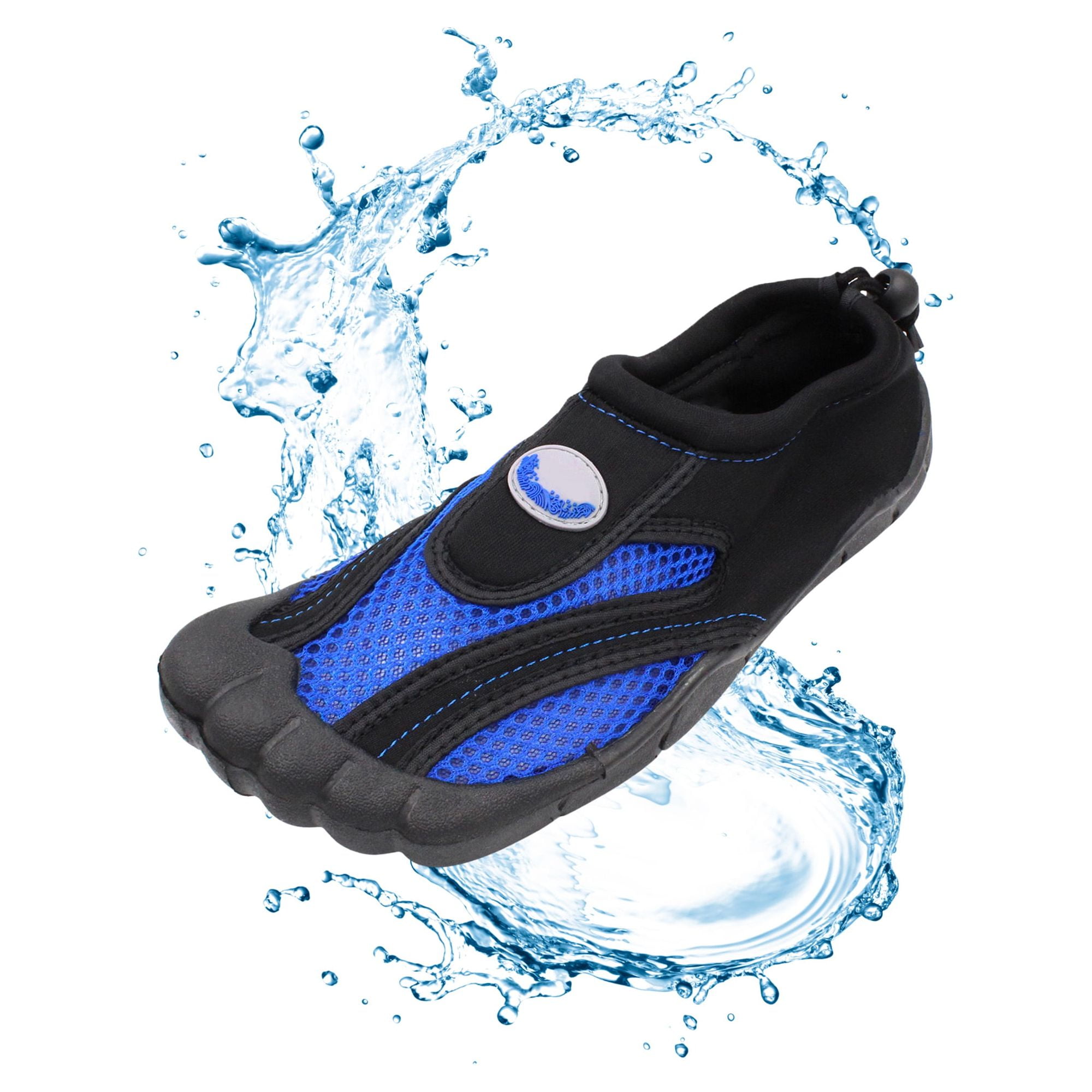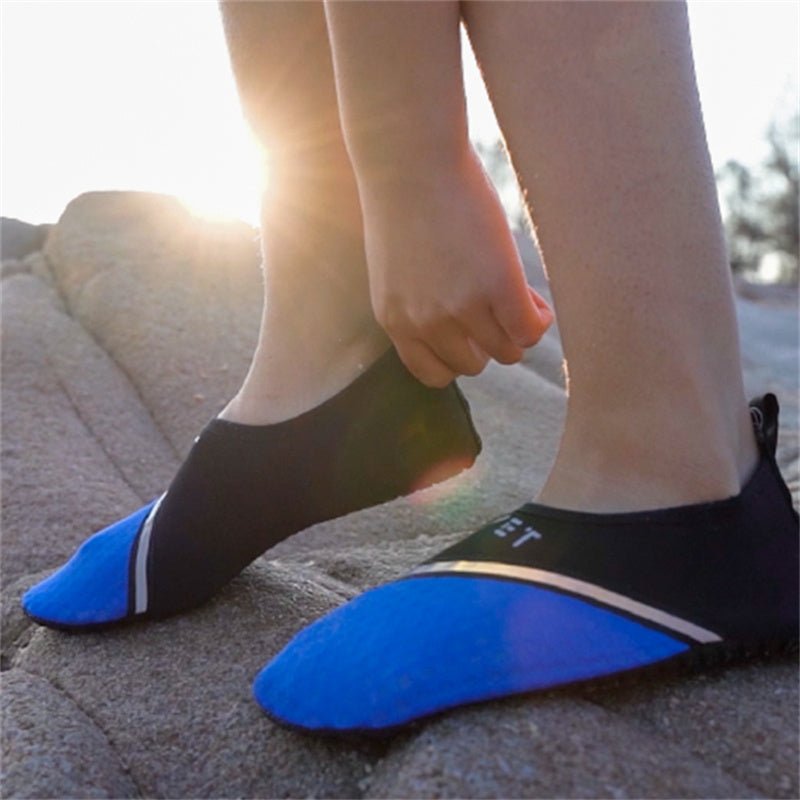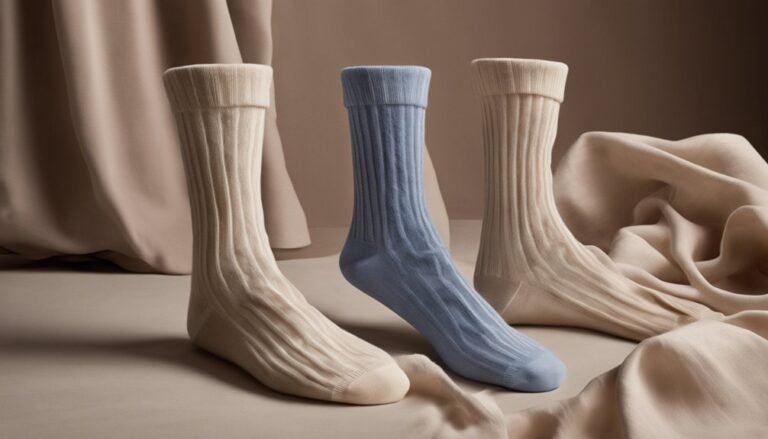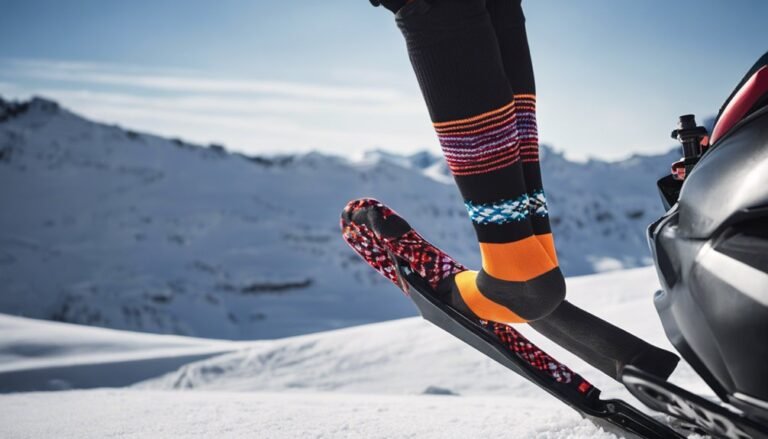Water Shoes Vs Aqua Socks: Ultimate Guide to Water Footwear
Water shoes and aqua socks are both great for water activities. Each has unique features that suit different needs.
Choosing the right footwear for water adventures can be tricky. Water shoes and aqua socks both offer protection and comfort, but in different ways. Water shoes often have sturdy soles, providing good traction and support. They are great for rocky beaches or hiking near water.
Aqua socks, on the other hand, are lightweight and flexible. They fit like a second skin, perfect for swimming or lounging by the pool. Understanding the differences can help you make the best choice for your water activities. Let’s dive into the details to find out which is best for your needs.

Introduction To Water Footwear
Water activities are fun and thrilling. But your feet need protection. Whether swimming, kayaking, or exploring a rocky beach, proper footwear is vital. This blog will explore two popular options: water shoes and aqua socks.
Importance Of Proper Water Footwear
Proper water footwear prevents injuries. They protect your feet from sharp rocks, shells, and hot sand. Water footwear also provides traction. Slippery surfaces can cause accidents. Comfortable and secure shoes enhance your experience.
Key Differences Between Water Shoes And Aqua Socks
Water shoes and aqua socks serve different purposes. Below is a table highlighting their key differences:
| Feature | Water Shoes | Aqua Socks |
|---|---|---|
| Material | Thicker, durable materials | Lightweight, flexible fabric |
| Sole | Thick, sturdy soles | Thin, flexible soles |
| Protection | High protection from sharp objects | Moderate protection, mostly from hot surfaces |
| Use Case | Hiking, rocky beaches, boating | Swimming, light beach activities |
Water shoes are ideal for rough terrains. They offer better protection and durability. Aqua socks are better for lighter activities. They provide comfort and flexibility. Choose based on your needs and activities.

Water Shoes Explained
Water shoes protect feet from sharp objects in the water, while aqua socks offer a snug fit for better swimming flexibility. Both provide comfort and safety, but water shoes are more durable for rocky terrains.
Water shoes offer excellent protection for your feet during water activities. They are versatile and designed to keep your feet safe and comfortable. Let’s explore their unique features and uses.Design And Materials
Water shoes often have a closed-toe design. This protects your toes from rocks and sharp objects. The materials used are quick-drying and breathable. Mesh panels allow water to escape quickly. Soles are made of rubber for better grip on slippery surfaces.Common Uses
Water shoes are perfect for a variety of activities. They are ideal for kayaking and rafting. You can wear them while snorkeling or swimming in rocky areas. They also work well for beach walking and tide-pooling. Many people use them for water aerobics too. “`Aqua Socks Unveiled
Aqua socks have become a popular choice for water enthusiasts. They offer a snug fit and protect feet from various underwater hazards. Unlike traditional water shoes, aqua socks are lightweight and flexible. Let’s dive deeper into what makes aqua socks unique.
Construction And Materials
Aqua socks are made from stretchy, breathable materials. Neoprene and spandex are common choices. These materials dry quickly and keep feet comfortable. The soles are usually thin but durable, providing traction on wet surfaces. This design ensures a barefoot-like experience while offering protection.
Typical Applications
Aqua socks are perfect for activities like swimming, snorkeling, and paddleboarding. They are also great for yoga and pilates sessions by the pool. Their lightweight nature makes them easy to pack for trips. Many people wear them on the beach to avoid hot sand and sharp objects. Aqua socks are versatile and suitable for various water-based activities.
Performance Comparison
Choosing between water shoes and aqua socks depends on their performance. Let’s explore their capabilities in two main areas.
Traction And Grip
Water shoes offer excellent traction on wet surfaces. They usually feature rubber outsoles with intricate tread patterns. This design provides a firm grip on slippery rocks and sandy beaches.
Aqua socks, on the other hand, have simpler soles. They offer decent grip but not as strong as water shoes. Aqua socks are better suited for activities like swimming and light beach walking.
| Feature | Water Shoes | Aqua Socks |
|---|---|---|
| Traction | High | Moderate |
| Grip | Firm | Decent |
Durability And Protection
Durability is another key factor. Water shoes are made with tough materials. They withstand harsh conditions and last longer. They protect your feet from sharp objects and rough terrains.
Aqua socks are lightweight and flexible. They offer basic protection but are less durable. They are great for casual water activities but not ideal for rugged environments.
- Water Shoes:
- High durability
- Strong protection
- Suitable for rugged use
- Aqua Socks:
- Lightweight
- Flexible
- Basic protection
Comfort And Fit
When selecting water shoes or aqua socks, comfort and fit are essential. These factors ensure you enjoy water activities without discomfort or blisters. Let’s explore the key aspects of comfort and fit in both water shoes and aqua socks.
Sizing And Adjustability
Proper sizing is crucial for comfort. Water shoes typically come in standard shoe sizes. They often include adjustable features like straps or laces. These help secure a snug fit. Aqua socks, on the other hand, are more flexible. They usually come in small, medium, or large sizes. Their stretchy material adapts to your foot shape. This flexibility can offer a more personalized fit.
Breathability And Drainage
Breathability and drainage are key for keeping feet dry. Water shoes often have mesh panels. These allow air to circulate and water to drain out. This helps to prevent the buildup of moisture. Aqua socks are made of quick-drying fabrics. They fit closely, but still allow water to escape. Both options aim to keep your feet comfortable and dry.
Suitability For Different Activities
Choosing between water shoes and aqua socks depends on the activity. Each type has benefits for specific uses. Let’s explore their suitability for various activities.
Beach And Swimming
Both water shoes and aqua socks are good for beach and swimming. Water shoes provide excellent protection from sharp objects, hot sand, and rocky surfaces. They have durable soles and secure fit.
Aqua socks, on the other hand, are lightweight and comfortable. They fit like a second skin. They are ideal for casual beach activities and swimming. Their thin soles offer less protection but more flexibility.
| Water Shoes | Aqua Socks |
|---|---|
| Durable soles | Lightweight |
| Secure fit | Flexible |
| Good protection | Comfortable |
Water Sports And Hiking
For water sports and hiking, water shoes are the better choice. They offer stability and grip on wet surfaces. They are designed for activities like kayaking, paddleboarding, and hiking through streams.
Aqua socks are less suitable for these activities. They lack the support and traction needed for rough terrains. Aqua socks are better for less intense activities.
- Water Shoes:
- Stability
- Grip on wet surfaces
- Support for rough terrains
- Aqua Socks:
- Lightweight
- Comfortable for casual use
Pros And Cons
Choosing between water shoes and aqua socks can be challenging. Each has unique advantages and disadvantages. Understanding these can help you make the right choice for your needs.
Advantages Of Water Shoes
- Durability: Water shoes are built to last. They are made of sturdy materials that can withstand rugged terrains.
- Protection: These shoes offer excellent foot protection. They guard against sharp rocks, shells, and other underwater hazards.
- Support: Water shoes provide good arch and ankle support. This makes them suitable for long hikes or water sports.
Benefits Of Aqua Socks
- Comfort: Aqua socks are lightweight and fit snugly. They feel like a second skin, providing maximum comfort.
- Flexibility: These socks allow for a full range of motion. They are ideal for activities that require agility.
- Quick Drying: Made from fast-drying materials, aqua socks dry quickly. This reduces the risk of blisters and discomfort.
| Feature | Water Shoes | Aqua Socks |
|---|---|---|
| Durability | High | Moderate |
| Protection | Excellent | Basic |
| Comfort | Good | Excellent |
| Flexibility | Moderate | High |
| Quick Drying | Moderate | High |
Choosing The Right Footwear
When selecting the right footwear for water activities, two popular options come to mind: water shoes and aqua socks. Choosing the right one can make a significant difference in comfort and performance. This section will help you understand the key differences and factors to consider when deciding between water shoes and aqua socks.
Factors To Consider
There are several important factors to consider when choosing between water shoes and aqua socks. Here are the main points to keep in mind:
- Activity Type: Consider the type of activity you’ll be doing. Water shoes are ideal for activities involving rough terrain or rocky surfaces. Aqua socks are better for light activities like swimming or walking on the beach.
- Comfort: Water shoes often have more support and cushioning. Aqua socks are lightweight and flexible, providing a barefoot feel.
- Protection: Water shoes offer better protection against sharp objects and rough surfaces. Aqua socks provide minimal protection, suitable for smooth surfaces.
- Durability: Water shoes are generally more durable and long-lasting. Aqua socks may wear out faster with frequent use.
- Fit: Both options should fit snugly but comfortably. Ensure there is no slipping or chafing.
Top Brands And Recommendations
Here are some top brands and their popular models for both water shoes and aqua socks:
| Brand | Water Shoes | Aqua Socks |
|---|---|---|
| Speedo | Surfwalker Pro | Zipwalker |
| Merrell | Hydro Moc | N/A |
| Vibram | FiveFingers V-Aqua | N/A |
| Body Glove | 3T Barefoot | Skin Diver |
Choosing the right footwear depends on your specific needs and preferences. Consider the factors mentioned above and explore the recommended brands for the best experience.
Care And Maintenance
Proper care and maintenance of water shoes and aqua socks can extend their lifespan. Regular cleaning and correct storage can keep them in top condition. Below are some tips to help you maintain your water footwear.
Cleaning Tips
Keeping your water shoes and aqua socks clean is essential. Regular cleaning prevents odors and extends their life. Follow these steps:
- Rinse them with fresh water after each use.
- Use mild soap and a soft brush for deeper cleaning.
- Avoid harsh chemicals that can damage the material.
- Let them air dry completely before storing.
For stubborn stains, consider using a mixture of vinegar and water. This natural solution can help remove dirt without harming the fabric. Remember to rinse thoroughly afterward to remove any residue.
Storage Advice
Proper storage is key to maintaining the shape and functionality of your water shoes and aqua socks. Here are some tips to ensure they stay in good condition:
- Store them in a cool, dry place.
- Avoid direct sunlight, which can cause fading and material breakdown.
- Use a shoe rack or breathable bag for storage.
- Keep them away from heavy objects to prevent deformation.
These simple steps can help you keep your water footwear in great shape. Taking care of them means they will be ready for your next adventure.

Frequently Asked Questions
What’s The Difference Between Aqua Socks And Water Shoes?
Aqua socks are lightweight and flexible, providing minimal protection. Water shoes offer more support and protection with sturdy soles.
Can You Swim In Aqua Socks?
Yes, you can swim in aqua socks. They provide grip and protect your feet in and out of water.
What Are Aqua Socks Used For?
Aqua socks protect feet from sharp objects, hot surfaces, and slippery areas while swimming or walking on wet terrain.
Are Water Socks Worth It?
Yes, water socks are worth it. They provide protection, comfort, and grip for water activities. Ideal for swimming, snorkeling, and beach outings.
Conclusion
Choosing between water shoes and aqua socks depends on your needs. Water shoes offer robust protection and durability. Aqua socks provide flexibility and comfort. Both options have their benefits. Consider your activities and environment. Water shoes are great for rocky terrains.
Aqua socks work well on sandy beaches. Evaluate your priorities before making a decision. The right choice ensures a better experience. Stay comfortable and safe in your water adventures. Happy exploring!







